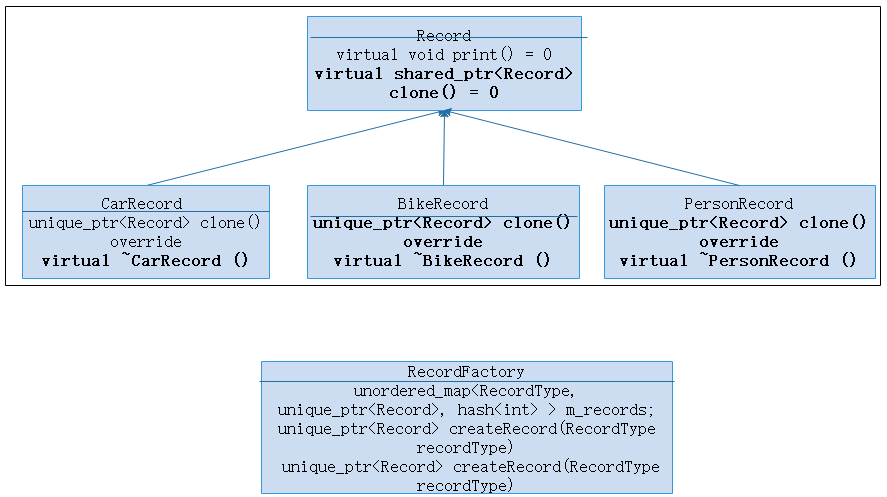原型模式用于软件开发,当要创建的对象类型由原型实例确定时,该原型实例被克隆以生成新对象。这种方式应用于以标准方式创建对象的代价比较大时,采用这种方式。
实现 声明一个基类指定以个特殊的纯虚函数 virtual clone()方法。任何需要“多态构造函数”的类能力的类都需要从它派生出来并且实现clone()函数。
这儿有一个客户端代码,这个工厂模式,依赖于参数,查找具体的创建类。在具体类中,clone()方法调用,并且返回工厂方法。
如下 是一个例子:
Record 类,是一个纯虚类,包含纯虚函数clone()
CarRecord,BikeRecord,和 PersonRecord是Record类的具体的类
一个枚举类型 RecordType作为一个一对一的映射,去实现每一个Record class的实现。
RecordFactory 类有一个工厂方法 CreateRecord(...).这个方法需要一个枚举类型作为参数,并且依赖于该参数返回Record class 的具体实现。
/** Implementation of Prototype Method **/
#include <iostream>
#include <unordered_map>
#include <string>
#include <memory>
using namespace std;
/** Record is the base Prototype */
class Record
{
public:
virtual ~Record() {}
virtual void print() = 0;
virtual shared_ptr<Record> clone() = 0;
};
/** CarRecord is a Concrete Prototype */
class CarRecord : public Record
{
private:
string m_carName;
int m_ID;
public:
CarRecord(string carName, int ID) : m_carName(carName), m_ID(ID)
{
}
void print() override
{
cout << "Car Record" << endl
<< "Name : " << m_carName << endl
<< "Number: " << m_ID << endl << endl;
}
shared_ptr<Record> clone() override
{
return make_shared<CarRecord>(*this);
}
};
/** BikeRecord is the Concrete Prototype */
class BikeRecord : public Record
{
private:
string m_bikeName;
int m_ID;
public:
BikeRecord(string bikeName, int ID) : m_bikeName(bikeName), m_ID(ID)
{
}
void print() override
{
cout << "Bike Record" << endl
<< "Name : " << m_bikeName << endl
<< "Number: " << m_ID << endl << endl;
}
shared_ptr<Record> clone() override
{
return make_shared<BikeRecord>(*this);
}
};
/** PersonRecord is the Concrete Prototype */
class PersonRecord : public Record
{
private:
string m_personName;
int m_age;
public:
PersonRecord(string personName, int age) : m_personName(personName), m_age(age)
{
}
void print() override
{
cout << "Person Record" << endl
<< "Name : " << m_personName << endl
<< "Age : " << m_age << endl << endl;
}
shared_ptr<Record> clone() override
{
return make_shared<PersonRecord>(*this);
}
};
/** Opaque record type, avoids exposing concrete implementations */
enum RecordType
{
CAR,
BIKE,
PERSON
};
/** RecordFactory is the client */
class RecordFactory
{
private:
unordered_map<RecordType, shared_ptr<Record>, hash<int> > m_records;
public:
RecordFactory()
{
m_records[CAR] = make_shared<CarRecord>("Ferrari", 5050);
m_records[BIKE] = make_shared<BikeRecord>("Yamaha", 2525);
m_records[PERSON] = make_shared<PersonRecord>("Tom", 25);
}
shared_ptr<Record> createRecord(RecordType recordType)
{
return m_records[recordType]->clone();
}
};
#include <iostream>
#include "prototype.cpp"
using namespace std;
int main()
{
RecordFactory recordFactory;
auto record = recordFactory.createRecord(CAR);
record->print();
record = recordFactory.createRecord(BIKE);
record->print();
record = recordFactory.createRecord(PERSON);
record->print();
return 0;
}另外一个例子,为了实现该模式,声明一个抽象基类,指定一个纯虚函数 clone()作为成员变量。任何一个类想实现多态构造函数的能力必须继承该抽象基类,并且实现clone()函数。
客户端代码,不是通过触发new操作实现,而是调用clone()成员函数,调用工厂成员函数设计特殊的具体派生类。或者触发clone()机制
